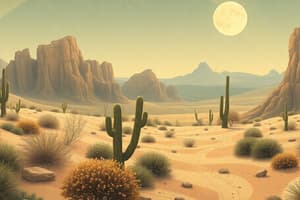Podcast
Questions and Answers
¿Cuál de las siguientes afirmaciones describe mejor la relación entre productores y consumidores en una red trófica?
¿Cuál de las siguientes afirmaciones describe mejor la relación entre productores y consumidores en una red trófica?
- Los productores son alimentados por consumidores de orden superior.
- Los consumidores dependen de los productores para obtener energía. (correct)
- Los productores son alimentados únicamente por otros productores.
- Los consumidores no tienen relación con los productores.
¿Cómo afecta la temperatura a la biodiversidad en los biomas?
¿Cómo afecta la temperatura a la biodiversidad en los biomas?
- Temperaturas bajas favorecen una mayor diversidad de vida.
- Temperaturas moderadas siempre reducen la biodiversidad.
- La temperatura no tiene impacto en la fauna de un bioma.
- Temperaturas más altas generalmente soportan formas de vida más diversas y abundantes. (correct)
¿Cuál de los siguientes factores climáticos NO impacta en las características de un bioma?
¿Cuál de los siguientes factores climáticos NO impacta en las características de un bioma?
- La altura de los edificios cercanos. (correct)
- La duración e intensidad de la luz solar.
- La disponibilidad de agua.
- Los patrones de viento.
¿Cuál es el efecto de la lluvia en los biomas?
¿Cuál es el efecto de la lluvia en los biomas?
¿Qué factor climático influye en el proceso de fotosíntesis en los biomas?
¿Qué factor climático influye en el proceso de fotosíntesis en los biomas?
¿Cuál de los siguientes biomas se caracteriza por tener altas temperaturas y lluvia durante todo el año?
¿Cuál de los siguientes biomas se caracteriza por tener altas temperaturas y lluvia durante todo el año?
¿Qué bioma tiene variaciones extremas de temperatura y baja precipitación?
¿Qué bioma tiene variaciones extremas de temperatura y baja precipitación?
¿Cómo se define la biodiversidad dentro de un ecosistema?
¿Cómo se define la biodiversidad dentro de un ecosistema?
¿Cuál de los siguientes factores no es considerado un componente abiótico de un ecosistema?
¿Cuál de los siguientes factores no es considerado un componente abiótico de un ecosistema?
¿Qué característica distingue a la pradera templada de otros biomas?
¿Qué característica distingue a la pradera templada de otros biomas?
¿Cómo fluye la energía a través de un ecosistema?
¿Cómo fluye la energía a través de un ecosistema?
¿Cuál es un efecto de la alta biodiversidad en un ecosistema?
¿Cuál es un efecto de la alta biodiversidad en un ecosistema?
¿Qué tipo de bioma es menos diverso en comparación con la selva tropical?
¿Qué tipo de bioma es menos diverso en comparación con la selva tropical?
Flashcards
Redes tróficas
Redes tróficas
Relaciones complejas de interdependencia entre productores, consumidores y los que los consumen, mostrando el flujo de energía y nutrientes en un ecosistema.
Cadenas tróficas
Cadenas tróficas
Secciones individuales dentro de las redes tróficas, mostrando las relaciones de alimentación directas entre organismos.
Temperatura
Temperatura
Factor climático que afecta la variedad de vida que puede sobrevivir en un área. Temperaturas más altas suelen soportar más vida.
Precipitación
Precipitación
Signup and view all the flashcards
Duración/intensidad de la luz solar
Duración/intensidad de la luz solar
Signup and view all the flashcards
Viento y relieve
Viento y relieve
Signup and view all the flashcards
Biomas
Biomas
Signup and view all the flashcards
Bioma
Bioma
Signup and view all the flashcards
Ecosistema
Ecosistema
Signup and view all the flashcards
Bosque Tropical
Bosque Tropical
Signup and view all the flashcards
Sabana
Sabana
Signup and view all the flashcards
Desierto
Desierto
Signup and view all the flashcards
Pradera Templada
Pradera Templada
Signup and view all the flashcards
Bosque Caducifolio Templado
Bosque Caducifolio Templado
Signup and view all the flashcards
Taiga
Taiga
Signup and view all the flashcards
Tundra
Tundra
Signup and view all the flashcards
Diversidad Biológica
Diversidad Biológica
Signup and view all the flashcards
Factores Abióticos
Factores Abióticos
Signup and view all the flashcards
Factores Bióticos
Factores Bióticos
Signup and view all the flashcards
Flujo de Energía
Flujo de Energía
Signup and view all the flashcards
Ciclos de Nutrientes
Ciclos de Nutrientes
Signup and view all the flashcards
Study Notes
-
Biomes are large geographical areas with similar climates, vegetation, and animal life. They are characterized by a specific set of abiotic factors, like temperature and rainfall, which influence the types of organisms that can survive there.
-
Ecosystems are smaller than biomes, and consist of all the living organisms (biotic factors) and non-living components (abiotic factors) in a particular area, interacting with each other. An ecosystem is self-sustaining, meaning it can support its own organisms.
Types of Biomes
-
Tropical Rainforest: High temperatures and rainfall year-round, supporting dense vegetation and high biodiversity. Very high primary productivity.
-
Savanna: Warm temperatures, wet and dry seasons, characterized by grasses, scattered trees, and large herbivores.
-
Desert: Extremely low precipitation, high temperature variations, and sparse vegetation. Adapted organisms are drought-tolerant.
-
Temperate Grassland: Moderate temperatures, with distinct wet and dry seasons, characterized by grasses, and grazing animals.
-
Temperate Deciduous Forest: Moderate temperatures, distinct seasons, with trees that lose leaves annually. Rich in decomposers and soil nutrients.
-
Taiga (Boreal Forest): Long, cold winters, short, cool summers, coniferous trees (evergreen). Limited biodiversity compared to rainforests.
-
Tundra: Very cold, low precipitation (mostly snow), permafrost layer, low-growing vegetation like mosses and lichens.
Ecosystem Characteristics
-
Biodiversity: refers to the variety of life within a specific area, including the abundance and distribution of species. High biodiversity correlates with resilience; ecosystems with more species generally have a better chance of surviving environmental changes.
-
Abiotic Factors: These are non-living components that shape an ecosystem, such as sunlight, temperature, water, and soil composition.
-
Biotic Factors: These are living components within an ecosystem, such as plants, animals, and microorganisms. They interact with each other and the abiotic factors via food webs and other relationships.
-
Energy Flow: Energy from the sun is captured by producers (plants), passed to consumers (herbivores, carnivores, omnivores), and eventually lost as heat.
-
Nutrient Cycling: Nutrients are continuously recycled within the ecosystem through various processes like decomposition, and nutrient uptake by plants. This cycling is essential for sustainability.
-
Food Webs and Chains: Producers feed consumers, and consumers are fed upon by other consumers, creating complex relationships of interdependence. These webs and chains illustrate the flow of energy and nutrients through the ecosystem.
Climate Impact on Biomes
-
Temperature: Influences the types of organisms that can survive in an area. Higher temperatures generally support more diverse and abundant life forms, and may also increase the rate of metabolic processes.
-
Rainfall: Crucial for plant growth and affects the water availability for all life in the biome. Different biomes exhibit varying patterns of rainfall, with some experiencing prolonged droughts, while others receive abundant rainfall.
-
Sunlight duration/intensity: Affects the rate of photosynthesis and overall energy available in a biome. Polar regions have short periods of sunlight, while tropical regions experience consistent sunlight.
-
Wind and topographic features: These further shape the climate and therefore the character of a biome. Wind patterns can influence air temperature and rainfall, impacting the types of plants and animals that can thrive, while mountains and valleys can influence local microclimates.
Studying That Suits You
Use AI to generate personalized quizzes and flashcards to suit your learning preferences.




